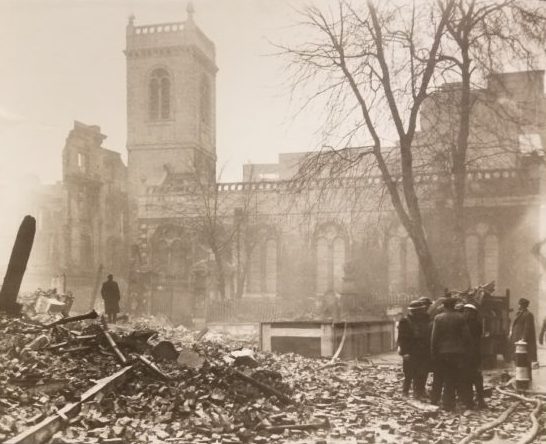The beautiful Church of St. Mary the Virgin, Aldermanbury stands on the campus of Westminster College as a magnificent survivor of the ravages of time and disastrous events. In fact, as a result of its fiery brushes with extinction, the Church is often compared to the Greek mythological bird, the phoenix, which, according to legend, would rise up from flames to find renewed life.
Originally constructed in the 12th century, the church was a rectangular shape of approximately one-third the size of the current church. While the church was enlarged during the Middle Ages with six side chapels added, the place of worship had fallen on hard times by the 15th century and might have deteriorated away if an alderman named Sir William Estfield had not funded a rebuilding project in 1437. The steeple was reconstructed, the five bells were recast “into more tunable ones,” and the church itself was enlarged. While the Church of St Mary the Virgin, Aldermanbury endured through the struggles of numerous civil wars, the Reformation, the early years of the Restoration, and even the plague of 1665, the Church met its match September 2, 1666, when the Great Fire of London burned on for five days destroying almost all of London north of the Thames River. Fortunately, St. Mary’s was one of the 51 churches from the 87 destroyed which was selected to be rebuilt by the great English architect Sir Christopher Wren.
Wren used the 15th century foundation of the church and segment of the tower which had survived the fire and rebuilt with columns supporting the barrel-vault ceiling in a design which represented the transition of his architectural style. The finished product incorporated both classic Paladian and English baroque. For nearly 300 years this tribute to Wren’s brilliance stood until the relentless and devastating World War II bombing of London by the Nazi Luftwaffe known as “the Blitz.” At 6:15 p.m. on Sunday evening, December 29, 1940, the first group of enemy planes dropped incendiary devices by the thousands to light the way for the bombers to come. During the three hour attack, 100,000 bombs fell on the city, creating 1,500 fires and destroying a larger section of London than the Great Fire of 1666. As a result, an American correspondent sent a cable to his office labeling the conflagration “The Second Great Fire of London.”
The Germans had timed their attack to hit when the Thames River was at low tide, and their bombs ruptured a main water main, which with all the other domestic demands on water pipes, led to a failure of water pressure. Since the Thames was at low tide, firefighters who attempted to use river water were stymied by hoses clogged with mud. The heroism of these firefighters and the London citizens was incredible. “While the men manned the pumps, the women were driving petrol carriers, canteen vans, and staff cars into the thickest part of the blaze, ensuring the pumps had fuel to keep going,” author Francis Beckett recalled. “Driving vans laden with petrol through flames at night was about as dangerous a job as you could do.”
While the Nazis were targeting communication lines, train stations, bridges, and London’s main telephone center, 31 guild halls, 19 churches (including 8 Wren churches), and the entire London publishing district, Paternoster Row, with five million of its books, were obliterated as well. With their wooden roofs, the churches were helpless victims of the siege. Incendiary bombs hitting the ground could be put out with sand, but when they hit those wooden roofs, the buildings burst into flames.
Ironically, Noel Mander, a soldier home on leave who was volunteering as a fire warden that night and would go on to construct the organ in Westminster’s restored church, saw the Church of St. Mary the Virgin, Aldermanbury burn. He recounted his experience in 1982: “I spent the night in Gresham St. in the city. We couldn’t do anything because the water mains had all been fractured, and the river was so low, record low, they couldn’t suck water up from there. They could do little, very little. Unfortunately, the churches were all locked, so we couldn’t get into them and I saw that night St. Mary, Aldermanbury; St. Vedast-alias-Foster, my own church-I saw them all burn, and it was a sensation I will never forget-hearing the bells fall down the tower, hearing the organs burn, because the hot air blowing through the organ pipes almost sounded as if the poor old organs were shrieking in agony in their destruction.”
By morning only a blackened shell of St. Mary’s and its columns remained. The furnishings, which included a 17th century chest, were completely destroyed. Wine in the communion chalices had been crystallized. Although many of the fires had been extinguished by 4 a.m., some burned on for days.
Even more devastating was the human toll. 163 dead. 503 injured with many of those succumbing from their injuries in the days that would follow. Prime Minister Winston Churchill toured the city and surveyed the damage. He wept. Yet, in spite of the horrible decimation, fate played a role in keeping the death and destruction from being worst. The German command had planned a second phase of the attack to follow but had to cancel because of bad weather.
From a rooftop view in Whitehall, Churchill further watched the city smolder and supposedly turned to an aide to say: “We’ll get the bastards for this.” Churchill kept that vow, and his determination and inspiration in the face of what appeared to be certain defeat emboldened the entire British nation to fight on to victory.
Meanwhile the remnants of the Church of St. Mary the Virgin, Aldermanbury, would lie in the center of London untouched until President Dr. Robert L.D. Davidson dreamed up what he called an “imaginative concept” to resurrect St. Mary’s to new life across the ocean on the small Midwestern campus of Westminster College. Make plans to visit this historic landmark and home of America’s National Churchill Museum for a celebration of the 50th anniversary of its restoration May 3-5 during Churchill Weekend at Westminster.
Follow America’s National Churchill Museum on social media and online at:
Facebook: National Churchill Museum
Twitter: @churchillmuseum
Instagram: @national_churchill_museum
Website: https://www.nationalchurchillmuseum.org








You must be logged in to post a comment.